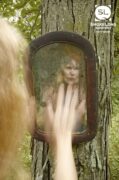You subtly mask what’s really happened in this story, the great tragedy that’s triggered this compulsive obsession disorder. Were you tempted to reveal more?
Definitely not. I like puzzling and subtext and interpretation as a reader, so I try to layer these elements into my own work. I want to discover when I read—and as I write. I didn’t know why the protagonist in “Paper Nests” was doing these things when I began drafting it; the story before the story peeked out at me just as it now peeks out at you, only fully revealing itself as I cultivated the last paragraph in my head. The important details are there, if you appreciate those connections—why this particular compulsion, what precipitated it, how and where the loss occurred; you might even manage to argue an approximate when. But the protagonist isn’t ready to look at any of that directly, so the story doesn’t, either.
You’re super-careful not to assign your protagonist a gender. Why was that important to you, too?
It was important to me to avoid identifying information about the protagonist in all respects. I knew fairly early I needed a detached first-person POV that read more like third person. Withholding everything—even personal pronouns, for most of the piece—felt intuitively necessary to engineer the distance I wanted to achieve without sacrificing the protagonist’s voice and unique perspective. Ultimately those descriptors are irrelevant, anyway. Everyone suffers. Anyone might cope in erratic or unproductive, even self-destructive, ways. In my head this character identifies as I do, but every reader will see someone different. The possibilities are universal, as suffering is universal. Hopefully this lends the piece a deeper resonance.
Your protagonist is resistant to the therapist at first, but eventually gets on board with the program. Do you see the ending of this story as a healing gesture, or perhaps rock bottom?
To me it’s a jarring final image—those Post-its piled up on the door—so I think we’re skirting rock bottom, or at least descending another step in a downward spiral. In her comments [Guest Editor] Jen Julian labeled the therapist’s suggestions “questionable,” and I think that’s pointedly accurate. I live with PTSD and have engaged several therapists over the years; one of my sisters is a social worker who specializes in court-ordered domestic abuse therapy and family arbitration. She’s taught me a lot about the dangers of confronting traumatic memories before a person has developed the skills to manage the emotional onslaught those memories trigger, and that emotional self-regulation is a vital prerequisite to any attempt at altering behavior. I think this is what you see playing out in “Paper Nests.” Though well intentioned, the therapist is driving her client too hard, too quickly, and without a proper map. Backfiring is inevitable.
Would you write this story any differently today, post-shutdown/hoarding, considering the state grocery stores are in currently?
Good question! I don’t think I would write the piece any differently, to be honest. So much of what we’re witnessing now—isolation, consequence, deprivation, loss, warning, containment, defiance—is already in the story. It’s humanity in crisis; it’s complicated and confusing. All suffering is. Humans are. Mix the two together and it’s every story, written, unwritten, rewritten.
What do your cupboards look like right now?
Inside? Full. We stocked a little extra over the weekend, not knowing what scarcities the next few weeks would bring. There’s a lot of pasta. I love pasta.
Outside: outdated. Picture saloon doors with ornate brass knockers centered on their faces. The whole kitchen needs an overhaul, but that’s a bigger project than we can accommodate right now. We did replace our microwave a few months ago. When we pulled the old one out we found two russet-colored mud dauber nests clinging to its back. Never saw the actual wasps, though. They were masters of social distancing.



 The core workshop of SmokeLong Fitness is all in writing, so you can take part from anywhere at anytime. We are excited about creating a supportive, consistent and structured environment for flash writers to work on their craft in a community. We are thrilled and proud to say that our workshop participants have won, placed, or been listed in every major flash competition. Community works.
The core workshop of SmokeLong Fitness is all in writing, so you can take part from anywhere at anytime. We are excited about creating a supportive, consistent and structured environment for flash writers to work on their craft in a community. We are thrilled and proud to say that our workshop participants have won, placed, or been listed in every major flash competition. Community works.